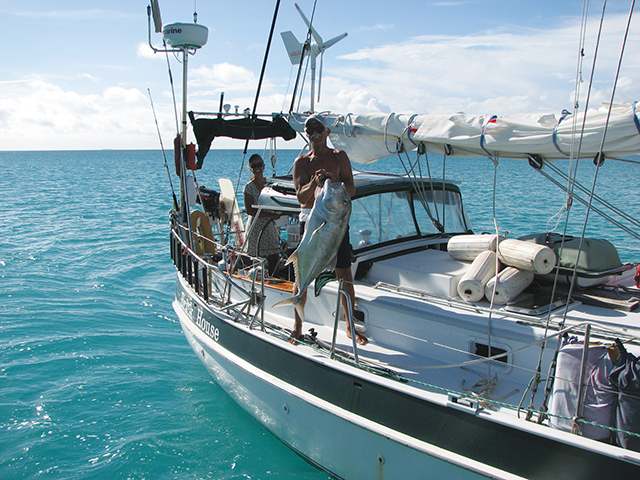(published October 2012)
Setting off from Rhode Island five years ago to sail around the world, we installed a multi-page list of new equipment on our old Valiant 40. But nothing on a long range cruising sailboat stays new for long. Here is a short list of items that are no longer shiny, yet still solid after five years and many thousands of sea miles—plus a few newer pieces of equipment that were a big disappointment.
AUTOPILOT
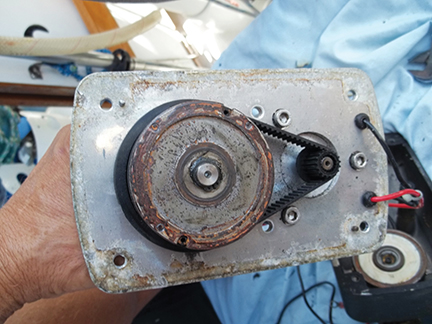
Five years ago we installed a new Raymarine electric autopilot (www.raymarine.com) with a mechanical type 2 linear drive. The linear drive is the part that actually moves the rudder from side to side. According to specifications, it was oversize for our boat, but we prefer the security of strong equipment that can perform the task when asked to work extra hard.
Over the years, our autopilot has performed extremely well. That is, until recently, when a cockpit seat drain installed using silicone sealant failed. Water dripped into the drive housing, rusting the electromagnetic clutch and causing it to slip, thereby reducing its ability to steer. One reason we installed the Raymarine autopilot was its ease of owner serviceability in the field. It was a surprisingly straightforward matter to disassemble the drive, clean rust from the clutch, then reassemble it and get things working again.
The leaking seat drain was rebedded with butyl sealant, which has successfully sealed our chainplates for years. Over time on Brick House, silicone sealant has failed in every situation in which it was applied.
HOOKAH
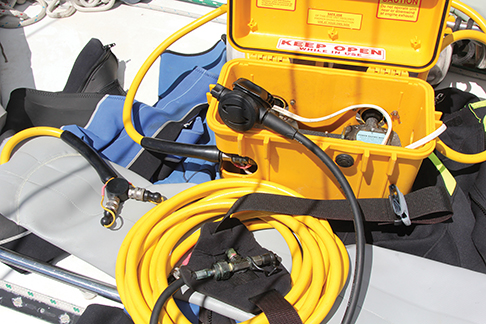
For five years, our Sea Breathe 12v dive compressor (www.seabreathe.com) has served us well. Connected to our house battery bank, it is used mostly for cleaning marine growth from the hull and changing prop shaft zincs while anchored in beautiful coves. The Sea Breathe also makes it much easier to retrieve dropped tools in up to 35 feet of water. We keep one SCUBA tank on board for deeper emergencies.
WINDLASS
When we left Newport five years ago, we installed a horizontal shaft windlass. In all this time, Lofrans’ Tigres model (www.imtra.com) has never hesitated to haul our 65-pound anchor and 300 feet of chain. I believe one reason for its success is that I installed the relay in a dry, secure area just outside the chain locker. Plus, periodically we clean all electrical connections to ensure full amperage flow to the motor.
SONAR
Our Lowrance LMS-525 C DF “fish finder” (www.lowrance.com) turned out to be a valuable navigational tool. With a maximum depth of just under 4,000 feet, it helps keep us safe in spots where depths can abruptly rise to coral-crunching shallows in a few boat lengths. Unfortunately, now our five-year-old machine will only display to 800 feet and the water temperature display vanished two years ago. With the installation of a new transducer, we hope to regain the original power.
STOVE
The Hillerange by Seaward (www.seawardproducts.com) was original to our 34-year-old boat. Since that model has not been produced for many years, we took parts from other Hilleranges found in used boat stores in Rhode Island and Florida to keep the top burners working. But recently, when the oven door decided to blow open while Rebecca was baking cookies, we realized that it was time not to rebuild, but rather to replace our good old stove.
We installed a new three-burner Gourmet 2 by Seaward, but the burners of the new stove only burn with dirty, soot-producing, yellow-tipped flames, effectively blackening the bottoms of our pots and pans. Replacing and adjusting the regulator and connecting a new tank of gas to a new gas line yielded no improvement. Although the stove is under warranty, all the manufacturer feels they can do for us is sell us more burners that are identical to those currently on the stove. Until this problem is solved, we have stock in a supply of scouring cleanser.
ENGINE-LIFTING STRAP
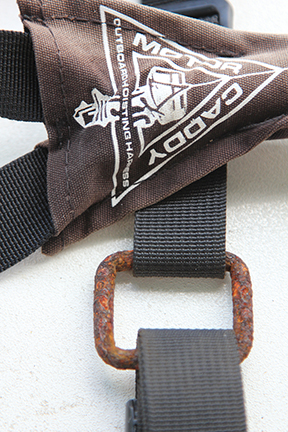
Our Easy-Lift outboard engine-lifting strap, which we used to lower the 15 hp engine onto the transom of the dinghy, lasted more than five years before a plastic buckle broke. Its replacement is a Davis Motor Caddy (www.davisnet.com). The only problem we’ve had with the Motor Caddy lies in the fact that after just several weeks of use, the square steel strap attachment suffered from severe rust and pitting. I had to eliminate the rusted piece and simply join the nylon straps to each other.
DECK LIGHT
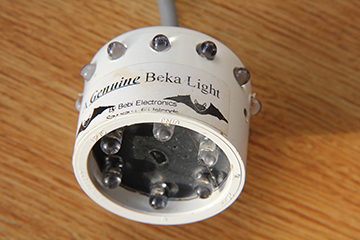
Our Bebi Electronics Beka Light (www.bebi-electronics.com) is an LED combo cockpit/anchor light that automatically turns on when the sun goes down. The light is bright and effective at discouraging burglars and marking our anchored position. It also uses a miniscule amount of DC energy when plugged into a 12v socket.
UNDERWATER LIGHT
Every cruising yacht needs a rugged underwater flashlight on board. In the middle of an ocean, at night, I have used our Light Cannon eLED (www.uwkinetics.com) to help free a polypropylene fish net from our prop. When we were dismasted, the underwater light was vital for making sure there was nothing to tangle in the prop or rudder before we motored off through the dark. We also use the light to look for lobsters along shallow reefs after the sun has gone down or to carry in the dinghy.
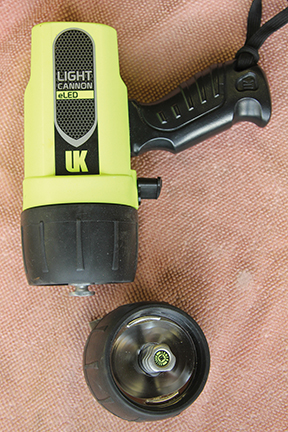
Underwater Kinetics describes their unique light as “Two high intensity LED arrays that are attached to a heat sink called the Lumen Booster, which is in direct contact with the water through the front lens.” The Lumen Booster cools the LEDs, allowing them to be brighter in water than in air. Plus, the whiter light of the LEDs seems to give better visibility than the yellowish light of my old incandescent underwater light. The light uses 8 “C” batteries, which burn up to an incredible nine hours. The “on” switch is a dual selector—choose the high beam or the energy-saving low beam. The light is made of a tough plastic and has a depth rating of 500 feet.
PROPELLER
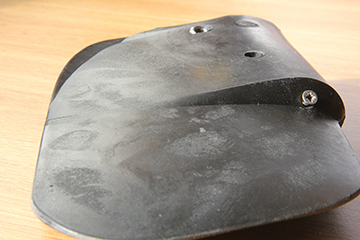
Since we have a hydraulic transmission bolted to our diesel engine, the only way to lock the drive shaft in reverse to stop the rotation of our old fixed-bladed prop or our old bronze “feathering” prop was to idle the engine, and then while shifting into reverse, simultaneously shut down the engine. With our composite and stainless steel Kiwiprop (www.kiwiprops.co.nz), we simply shift to neutral and shut down the engine. This is far less jolting to the transmission and linkages.
The three blades of the Kiwiprop are not geared to each other, so they are free to feather independently, unlike the bronze props, which do not truly feather in the direction of boat travel. However, in winds above 30 knots with high ocean waves, the Kiwiprop on our boat would start an autorotation at times. We had simple boat maneuvers to remedy this.
But now Kiwiprop has added a Flettner foil—small 4mm wedges at the rear trailing edge of each prop blade. Without disturbing motoring performance, the Flettner foil increases blade-feathering stability so well that the Kiwiprop is suitable for performance catamarans that sail in excess of 15 knots.
HEALTH
After having our blood tested recently, Rebecca and I were surprised to find our cholesterol levels to be “normal.” We can only attribute the results to our cruising lifestyle. Cruising remote Pacific islands has distanced us from the grease pit fast food joints and unhealthy snacks that were a normal part of our past city life.
Because of their scarcity where we sail, we eat far fewer eggs and beef, and far more fresh fish, oatmeal, grains, locally grown tubers, fruits, vegetables and coconut. In fact, we eat so much coconut and coconut cream—squeezed from freshly grated coconut—that I was worried about the “bad” effects of all that coconut oil. According to the always-reliable Internet, years ago competing soybean growers spent millions on an anti-coconut oil campaign; in actuality, coconut oil increases HDL, the “good” cholesterol.
One item on our boat that did cause us health problems was Crystal Light. Mixed with water, Crystal Light simulates the taste and texture of an assortment of fruit juices so well that we drank it exclusively from morning through night every day. Too much of this good thing, we eventually discovered, was the cause of our severe and persistent indigestion and acid reflux. We had to greatly cut back our consumption and drink more plain water. We do not stock sugary canned drinks on our boat due to the calories, stowage problems and expense.
The one thing our cruising lifestyle does not contribute to is muscle tone. We have to make more than a casual effort to hike trails, snorkel reefs and strain ourselves to keep our muscles in shape.
Having reached the mid-Pacific, we have no idea when Brick House will cross its outbound tracks; it could be another five to 10 years. Because of that long-range uncertainty, we do what we can to install equipment and take care of ourselves so everything will be working perfectly when we reach another ocean on the other side of the world.
“Who ever thought we would find an American oasis in the middle of the Pacific Ocean?” Quite by accident, Patrick and Rebecca Childress secured one-year contract jobs at the U.S. Army missile tracking base at Kwajalein Atoll. It is all part of their world adventure, and in a few more months they will be sailing outbound once again.

















